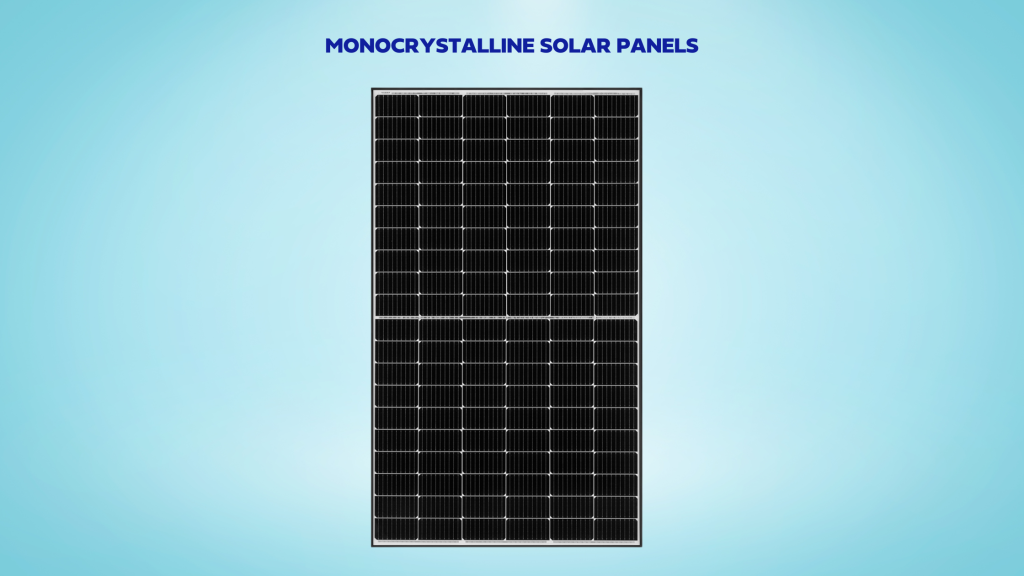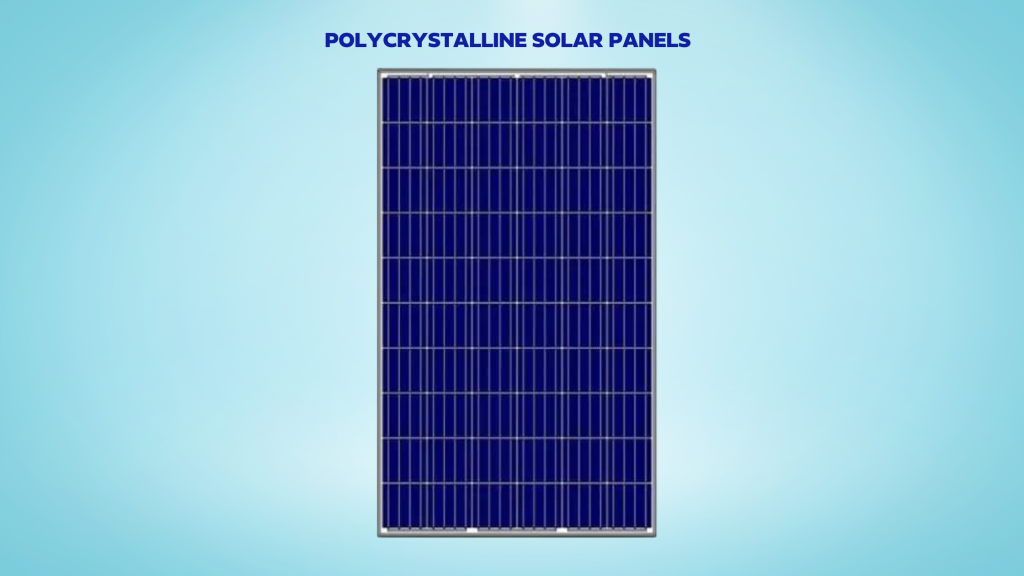
If you have decided to go solar, then this article is for you. Choosing between the right solar panels for your home might seem like a complicated task. You have to consider a lot of factors such as climatic conditions, budget, space required and much more. This article might help you in choosing suitable solar panels for your home or business.
While selecting solar panels you may come across two common categories: Monocrystalline solar panels and Polycrystalline solar panels.
Both monocrystalline and polycrystalline solar panels convert sunlight into energy using the same technique i.e. Photovoltaic Effect. Solar panels consist of solar cells that are made from layers of silicon, phosphorus, and boron. The composition of silicon in these solar cells is a major difference between monocrystalline and polycrystalline solar panels.
Monocrystalline Solar Panels

Generally, monocrystalline solar panels are considered under the premium category due to their high efficiency and sleek aesthetics. As the name suggests, the monocrystalline solar panels consist of single silicon crystals and often go by the name of single-crystal panels.
The monocrystalline cells are made from pure silicon which is shaped into bars. These bars are then sliced into thin octagonal-shaped wafer-forming cells.
The pure silicon gives these cells their unique dark blue hue because of which they are easily identified from other types of solar panels. The monocrystalline solar panels have higher efficiency as compared to their counterparts.
Further advancement in monocrystalline cells is the Half Cut cell. In this technology the square-shaped cells are sliced in the middle, resulting in twice the quantity of cells, half the size of the single square cell.
These cells are interconnected in such a way that the top portion of the panel has all cells associated in one series and the bottom half in another series. This permits the panels to proceed with power generation in the top half regardless of whether there is a shadow on the base portion of the board. Thus, the general power generation from half-cut cells is higher irrespective of shadow issues.
Another advanced technology which is combined with Monocrystalline Half Cut cells is the PERC technology (Passivated Emitter and Rear Cell).
Traditional solar panels absorb sunlight to a certain extent and some light passes straight through them. An additional layer is added to the back of the cells in PERC technology. This allows the unabsorbed sunlight to be absorbed again from the rear side of the panels, making them even more efficient.
Polycrystalline Solar Panels

Polycrystalline solar panels generally have a lower efficiency than monocrystalline solar panels. This means that you will require more panels to get the same output power. But this doesn’t mean that they are less preferred. Polycrystalline solar panels have a cost advantage and are more affordable compared to other solar panels.
The polycrystalline solar panel or “multi-crystalline” panels are also composed of the same materials i.e. silicon, but the process of manufacturing the cells is much simpler as compared to monocrystalline cells.
Unlike monocrystalline cells, polycrystalline cells are not made from a single crystal of silicon. Polycrystalline cells are made by melting many silicon fragments together which are then poured into square moulds for cooling.
After cooling, thin wafers are sliced out of these moulds and assembled to form cells. These cells are easily identified by their shining blue hue with straight edges.
Comparison chart: Monocrystalline v/s Polycrystalline Solar Panels
| Particulars | Monocrystalline Solar Panels | Polycrystalline Solar Panels |
| Cost | High | Low |
| Efficiency | High (19-21%) | Low (15-17%) |
| Appearance | These panels have black or dark blue hues with octagonal shape | These panels have blue hue with square edges |
| Temperature coefficient | Lower (0.35% per degC) | Higher (0.4% per degC) |
| Annual Degradation | Lower (0.55% per year) | Higher (0.7% per year) |
| Lifespan | 25+ years | 25+ years |
| Advantages | Energy efficientHeat-resistantLesser power output reduction over time | AffordableLess wastage in manufacturing processLow carbon footprint |
| Disadvantages | ExpensiveHigh carbon footprint | Low heat resistanceLower energy efficiency |
Let’s simplify this chart Monocrystalline vs Polycrystalline chart further for a better understanding:
Cost
Cost is the first consideration when it comes to the ever looming debate: Monocrystalline vs Polycrystalline, which of the two is better! So, let us elaborate on the topic.
Monocrystalline solar panels come under the category of premium solar panels and are expensive. This is because of the single silicon crystal used in making the cells and the complex manufacturing process.
On the other hand, polycrystalline solar panels are manufactured in a much simpler way by melting silicon fragments and cutting them into thin wafers. Because of this, polycrystalline solar panels are much more budget-friendly than monocrystalline solar panels.
Power Capacity
Next in our list of Monocrystalline vs Polycrystalline solar panels is their power capacity.
The power rating of solar panels is measured in Wp, i.e. Watt peak, which is the peak DC power generated by the panel under standard testing conditions. Different types of solar panels have different capacities in Wp due to their different efficiencies.
Mono-PERC Half Cut panels, which combine monocrystalline Half Cut cells with PERC technology have the highest power rating among commercially available solar panels. This is because of the high efficiency of monocrystalline cells combined with PERC technology.
Panels of up to 540 Wp DC power are available from most of the Tier 1 Chinese solar panel manufacturers. Polycrystalline solar panels are typically available in the range of 320 to 370 Wp.
Efficiency & Temperature Coefficient
Monocrystalline solar panels are highly efficient and generate more energy even during hot summers. Monocrystalline cells allow more space for the flow of electrons which helps in generating more energy.
Polycrystalline solar panels have lower efficiency and require more panels to generate the same output as monocrystalline solar panels. These panels are also more affected by higher temperatures.
The power generation capacity of Monocrystalline panels reduces by approximately 0.35% per 1 deg C increase in temperature.
For polycrystalline panels, the degradation is around 0.40% per deg C.
Annual Degradation
Let’s now explore another very important feature in the Monocrystalline vs Polycrystalline debate: Annual Degradation!
The power rating of the panels is reduced over the 25-year life of the panel. Both mono & poly panels reduce in rating by about 2% after 1 year of operation.
In years 2 to 25, monocrystalline panels reduce in rating by 0.55% per year and polycrystalline panels by 0.7% per year.
Hence, monocrystalline panels lose approximately 15% of their power rating at the end of 25 years and polycrystalline panels lose about 19% over the same period.
Appearance
Monocrystalline solar panels tend to have black or dark blue hues with octagonal shapes. Whereas, polycrystalline solar panels have blue hues with square edges.
Lifespan
Both monocrystalline and polycrystalline solar panels generally have an average lifespan of 25+ years. However, while considering the lifespan of solar panels, you should always look for companies that offer better power production warranty.
Monocrystalline v/s Polycrystalline Solar Panels: Deciding Factors
If you are still confused about the decision between monocrystalline and polycrystalline solar panels, then consider these factors before making your decision.
Space constraint
If you have limited rooftop space available for solar installation, you should consider going for monocrystalline solar panels as 50 to 60% higher power capacity can be achieved in the same area as compared to polycrystalline panels. While the up-front cost of mono panels is higher, having a higher capacity plant will be beneficial in the long run by reducing your electricity bills much more.
On the other hand, if you have ample rooftop space available to go for a larger solar installation, then you can consider polycrystalline solar panels as a more economical option.
Personal Preferences
If you are looking for aesthetically pleasing solar panels for your roof, then you might consider monocrystalline solar panels. Their sleek design and black hue offer an aesthetic appeal to your solar structure. Alternatively, if you like to go with the simpler structure, then you can consider polycrystalline solar panels, which have a light blue tint.
Conclusion
Monocrystalline and Polycrystalline solar panels are the two most common categories of solar panels.
There are many factors that one should consider while choosing between these two solar panels. Although both monocrystalline and polycrystalline are made from silicon, they have different output and performance characteristics.
Whilst monocrystalline solar panels are preferred due to their efficiency, polycrystalline solar panels are popular as they are more affordable. However, you should consider all the pros and cons as mentioned in this guide on Monocrystalline vs Polycrystalline solar panels before making your decision.
Frequently Asked Questions
1. What is better Monocrystalline or Polycrystalline?
If your preference is based upon efficiency and appearance, Monocrystalline panels are better. If you’re more concerned about the cost, Polycrystalline is the better option of the two.
2. Which type of solar panel is best for home use?
Polycrystalline solar panels are best for residential purposes.
3. Is Monocrystalline more expensive than Polycrystalline?
Yes. The manufacturing process of Monocrystalline panels is much complicated than polycrystalline panels. Hence, it’s more expensive.
